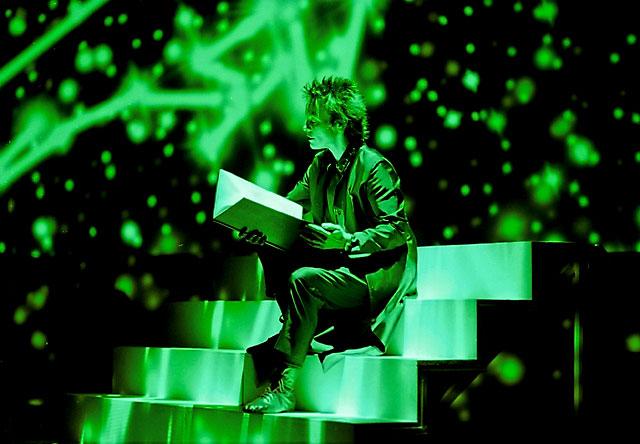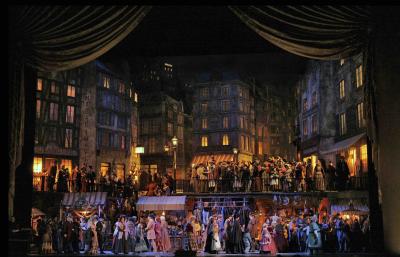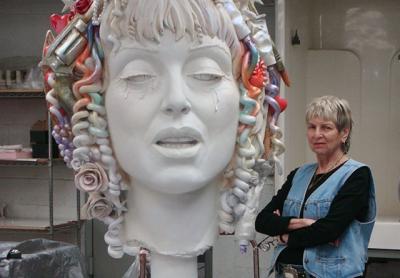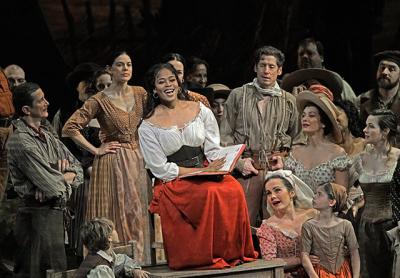David Kennedy Cutler’s Quadrophenia on Newtown Lane
David Kennedy Cutler’s Quadrophenia on Newtown Lane
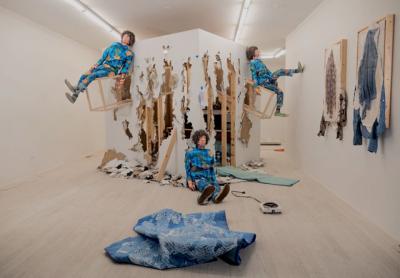
Staring into the front picture window or tuning into the live feed on the website of Halsey McKay Gallery in East Hampton, the current downstairs exhibition, “Off Season,” often looks like a tableau, static and formal, multiple mannequins posed just so to make an overall balanced composition.
Suddenly, one of the lifeless forms moves. It’s eerie and unnerving. Some people have even jumped, according to David Kennedy Cutler, the artist who has created this installation and is one of the dummies who actually moves throughout it.
He shares the space with four inert mannequins all dressed the same, with faces and hair that are generalized versions of the artist himself. When working as part of the installation, something he typically does over long weekends as he balances a job teaching at New York University, he dresses the same and dons a mask and wig that match the faces and hair he has given his clones. They all look “very close to my persona, but distilled in a way,” he said in the gallery recently.
So far, his winter residency has consisted of building a hermetic cube in the center of the gallery that surrounds a huge wide-format printer and a sleeping crate underneath it. He has since set about ripping apart much of the drywall around the cube to create “doors and windows,” freeing his dummies to move about the space and breathe life into their story.
There’s myth, science fiction, Freud, and even a touch of Marx in this wide-ranging project that addresses humanity, survival, and the act of creation. Dressed like his dummies, he has given himself only one hole in the mask by one of his eyes, which makes breathing and seeing more difficult. The gloves he wears, made of fabric designed to look like mechanical hands, constrain him so that he is less dexterous, sometimes clumsy.
At the same time, he has assigned himself many tasks: making artworks related to survival (clothing, food, companionship), tending to the dummies and the damage they sustain over time, and the tears and rips to his own costume. These and other chores might seem basic, but they take on a Herculean character when he is so voluntarily compromised in his senses.
The evidence of his productivity is all around: his shelter, the sleeping crate he built for himself and the Plexiglas and wood versions for his dummies, the board he fashioned to walk with them about the gallery, his “fresco” shirts and other artworks he has in progress with potatoes and shoes as subject matter, the moving blanket painted and decorated with images of Dentyne Ice packages.
A camera monitors his activities for the live stream, which is on YouTube and the gallery’s home page. When he views himself in the four-hour playback loop, his labors “seem very programmatic. There’s no joy in it.” With the mask limiting his ability to express himself, “you can’t perceive how I’m feeling or emoting, but there is a sense that what I’m doing is not easy.”
Over the years, Mr. Cutler has worked as an art installer with many private and public clients on the South Fork, and has visited often. In this job, “you’re theoretically a working-class person, but you’re allowed access to this really rarified, privileged world of wealth. You’re an artist, but not supposed to commune with the object you’re installing. You have to wear gloves and clean socks, and smell okay. There is a barrier between you and the world in these scenarios,” he said. “Part of that is a performance. . . . I think about this a lot: What is the expectation of your role in society? Those things are pretty operative in the work.”
His work in the gallery touches on installation, performance, and formalism. Yet the dummies, which he has been using in work since 2014, were an outgrowth of his initial training and work as a sculptor. “The only job of a sculptor is to make something stand up. Here, the dummies never really can.”
He is also fascinated by the way digital culture has entered and changed almost everything in our lives, particularly how it affects our identity. He describes it as a “dual conundrum between social media and capitalism that you are expected to magnify your natural abilities or identity disproportionally . . . a constant need to project an idealized image of yourself.” Multiplicity is also part of this, “where you are not just defined by one head shot or an author photo on the back of a book, but a perpetual maintenance of identity, a projection of the self out into the world. . . . Experience is only valid via the document or image of it taking place.”
An outgrowth of that phenomenon is the manipulation of such images or documents so that no one can be sure what is real or manufactured. “I like to toy with that feeling of the uncanny . . . that rupture in perception, that thing that makes the commonplace strange,” he said.
Filming all of the residency on a digital camera, he may produce a post-exhibition film. After he leaves the gallery, he said he might take field trips with his posse to his clients’ houses, setting up more travails, maybe walking five across up a flight of stairs, or sitting down with them to watch television. For now, they can all still be seen in the Newtown Lane gallery, viewed through the picture window, or watched on live stream at halseymckay.com through March 24

